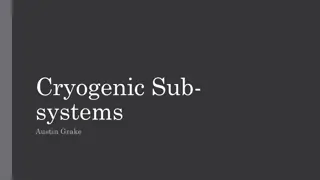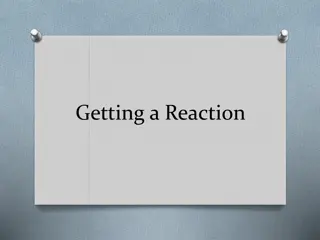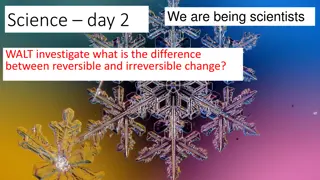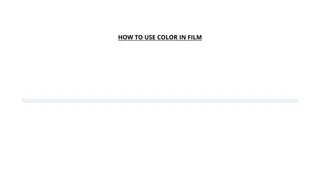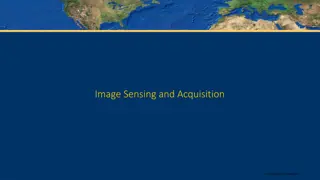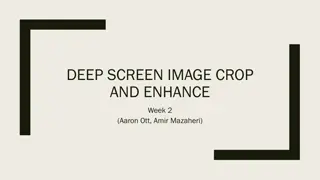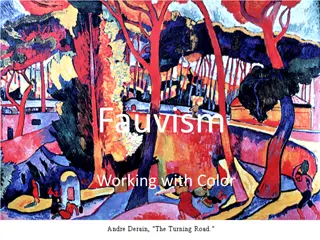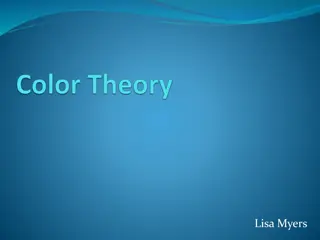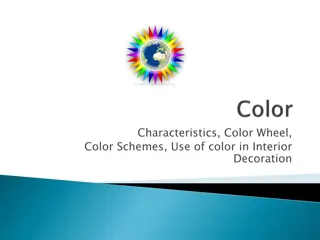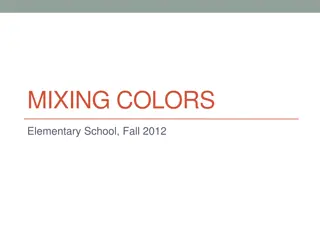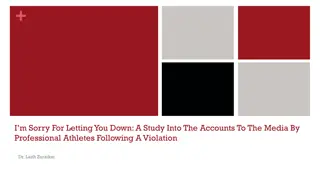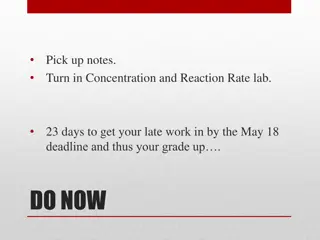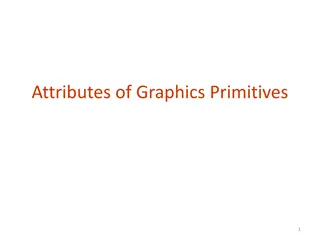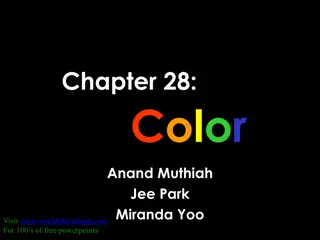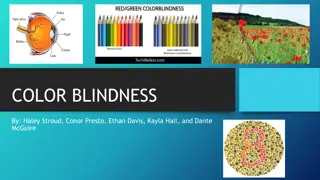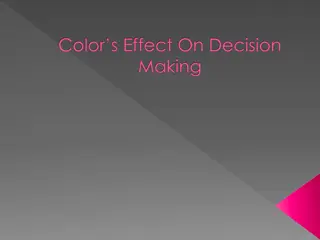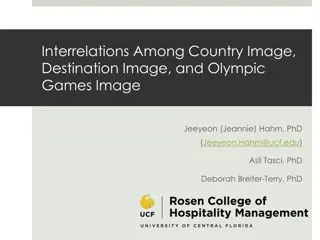
Reversible Color Image Watermarking in YCoCg-R Color Space
Explore the world of reversible color image watermarking in the YCoCg-R color space, covering topics such as embedding capacity, color space selection, theoretical justifications, and transform coding gain. Discover the secrets and challenges of embedding watermarks in color images while maintaining reversibility and data integrity.
Download Presentation

Please find below an Image/Link to download the presentation.
The content on the website is provided AS IS for your information and personal use only. It may not be sold, licensed, or shared on other websites without obtaining consent from the author. If you encounter any issues during the download, it is possible that the publisher has removed the file from their server.
You are allowed to download the files provided on this website for personal or commercial use, subject to the condition that they are used lawfully. All files are the property of their respective owners.
The content on the website is provided AS IS for your information and personal use only. It may not be sold, licensed, or shared on other websites without obtaining consent from the author.
E N D
Presentation Transcript
Reversible Color Image Watermarking in YCoCg-R Color Space Aniket Roy under the supervision of Dr. Rajat Subhra Chakraborty
Todays talk Reversible watermarking Problem in color image reversible watermarking color space exploitation: YCoCg-R color space Conclusion Weekly Talk 15, SEAL, IIT Kharagpur 11-08-2015
Reversible Watermarking Secret information i.e, watermark is embedded into the cover medium such that both the watermark and the cover image can be retrieved bit-by-bit. Cover medium can be image, audio or video. Here we consider reversible image watermarking. Watermark is generally a hash of cover image. Used in the industries dealing with highly sensitive data medical, military, legal industries etc. Weekly Talk 15, SEAL, IIT Kharagpur 11-08-2015
Watermark Embed Watermarked image Cover image Cover image Extract Watermarked image Watermark Weekly Talk 15, SEAL, IIT Kharagpur 11-08-2015
Problems in color image reversible watermarking Existing algorithms deal with mainly grayscale images. Color image reversible watermarking algorithms are just an extention of grayscale algorithms in R, G, B color spaces. Problem of selecting proper color space for reversible watermark embedding is not fully exploited. Weekly Talk 15, SEAL, IIT Kharagpur 11-08-2015
So the question arises. Which is the appropriate color space for high embedding capacity reversible color image watermarking? What is the theoretical justification for choosing such color space? Is there any added constraint for selecting color spaces for reversible watermarking? Weekly Talk 15, SEAL, IIT Kharagpur 11-08-2015
Transform Coding Gain When we transform the representation of color image from one color space to another , Transform Coding Gain is defined as the ratio of the arithmetic mean to the geometric mean of the variances of the variables in the new transformed domain co-ordinates. Transform Coding Gain is a metric to estimate compression performance. Weekly Talk 15, SEAL, IIT Kharagpur 11-08-2015
Sepian-Wolf Coding Theorem Given two correlated finite alphabet random variables X and Y, the theoretical bound for lossless coding rate for distributed coding of two sources are related by, i.e, the total rate R = H(X,Y) is sufficient for lossless encoding of two correlated random sequences X and Y. Weekly Talk 15, SEAL, IIT Kharagpur 11-08-2015
Capacity Maximization: Proposition : If the cover color image is (losslessly) converted into a different color space with higher coding gain , i.e, better compression performance before watermark embedding , then the watermark embedding capacity in the transformed color space is greater than the original color space. Weekly Talk 15, SEAL, IIT Kharagpur 11-08-2015
Consider color components of a color image are three discrete random variable X, Y and Z as shown in venn diagram. Area of each circle is proportional to its entropy. A bijection T is applied from original sample space (X,Y,Z) to (X ,Y ,Z ). Transform T has higher coding gain i.e, better compression performance. T is invertible and lossless. Weekly Talk 15, SEAL, IIT Kharagpur 11-08-2015
Venn Diagram : Weekly Talk 15, SEAL, IIT Kharagpur 11-08-2015
Transform T makes intra-correlation of the color channels high. High correlation between values implies less entropy. Joint entropy of X,Y and Z is denoted by H(X,Y,Z) and represented by the union of the three circles as depicted in fig. Weekly Talk 15, SEAL, IIT Kharagpur 11-08-2015
We can draw an analogy between lossless watermarking and lossless encoding . We have to losslessly encode the cover image into the watermarked image so that it can be retrieved bit-by-bit. We can use sepian-wolf coding to estimate the capacity of reversible watermarking. Weekly Talk 15, SEAL, IIT Kharagpur 11-08-2015
Color image I consist of color channels X,Y and Z. Let its size be N bits. Applying sepian-wolf theorem, we need a minimum coding rate of H(X,Y,Z) bits for lossless encoding of color channels. Remaining bits we can use for data embedding. i.e, capacity, C = N H(X,Y,Z). Weekly Talk 15, SEAL, IIT Kharagpur 11-08-2015
If we compare the color spaces (X,Y,Z) and (X ,Y ,Z ). For 1st color space, For 2nd color space, As, That implies, i.e, color space transform T results higher embedding capcity. Weekly Talk 15, SEAL, IIT Kharagpur 11-08-2015
RCT color space: Lossless color transform used in JPEG 2000 standard. Reversible and integer-to-integer transform. Weekly Talk 15, SEAL, IIT Kharagpur 11-08-2015
O1O2O3 color space: Lossless color transform with high compression ratio. Integer-to-integer reversibility. Weekly Talk 15, SEAL, IIT Kharagpur 11-08-2015
YCoCg-R color space: Higher transform coding gain. Acheives close to optimal compression performance. Integer-to-integer reversibility. Lower correlation among color channels. Simple and Efficient implementation in software and hardware. Weekly Talk 15, SEAL, IIT Kharagpur 11-08-2015
Embedding Algorithm: 1. Color Space transform: Transform the color cover image from RGB to YCoCg-R color space using transformation: Weekly Talk 15, SEAL, IIT Kharagpur 11-08-2015
2. Pixel Prediction: Weekly Talk 15, SEAL, IIT Kharagpur 11-08-2015
Pixel prediction: We use weighted mean based pixel prediction proposed by Luo et. al: Interpolated values along directions 45 and 135 are calculated. Interpolation error corresponding to the pixel at position (2i,2j) along 45 and 135 directions are calculated: Sets are formed as, Mean value of the base pixels around the pixel to be predicted, denoted by u. Weekly Talk 15, SEAL, IIT Kharagpur 11-08-2015
In the weighted mean based prediction, weights of the means are calculated using variance along both diagonal direction. Variance along 45 and 135 are denoted as are calculated as: Weights of the means along 45 and 135 directions are denoted by, Estimate the first level predicted pixel value p , as a weighted mean of the diagonal interpolation terms: Weekly Talk 15, SEAL, IIT Kharagpur 11-08-2015
Example: Mean45=(S45(1)+S45(3))/2 =(60+40)/2 =50 Mean135=(S135(1)+S135(3))/2 =(30+50)/2 =40 60 91 30 20 20 24 52 18 45 60 50 47 40 43 50 u= ( Mean45+ Mean135 )/ 2 = (50+40)/2 = 45 75 45 67 22 50 50 60 60 40 30 Cover image X 3 1 3 1 = = 2 ( ) ( ( ) ) 135 e S k u 2 ( ) ( ( ) ) e S k u 135 3 45 45 3 = 1 k = S45= {60, 52,40} 1 k = 83 3 . = 99 7 . S135={30, 52,50} = + ' 60 91 45 30 20 35 20 X w Mean w Mean 45 45 135 135 24 60 ( ) ( + ) 135 e e = + 45 50 40 50 40 50 + ( ) ( ) ( ) ( ) e 135 e e 135 e 50 45 75 50 45 45 = 5448 . 0 + 4552 . 0 50 40 50 Interpolation X 60 60 40 30 45 Weekly Talk 15, SEAL, IIT Kharagpur 11-08-2015
Example (Cont.) Mean0=(S0(1)+S0(3))/2 =(45+35)/2 =40 Mean90=(S90(1)+S90(3))/2 =(30+40)/2 =35 60 91 30 20 20 24 45 18 35 60 50 47 40 43 50 u= ( Mean0+ Mean90 )/ 2 = (40+35)/2 = 37.5 75 50 67 45 50 50 60 60 40 30 Cover image X 3 3 1 1 k = = 2 2 ( ) ( ( ) ) e S k u ( ) ( ( ) ) e S k u S0= {45,18,35} 90 90 0 0 3 3 = 1 = 1 k = 147.58 . = 147.583 S90={30,18,40} 60 91 30 20 20 = + ' X w Mean w Mean 35 43 0 0 90 90 24 60 45 46 38 ( + ) ( + ) e e 50 40 49 50 = + 90 0 35 48.5 45 ( ) ( ) ( ) ( ) e e e e 50 75 50 0 90 + 0 90 = 0.5 40 35 50 Interpolation X 60 60 40 30 0.5 38 Weekly Talk 15, SEAL, IIT Kharagpur 11-08-2015
Embedding Algorithm: Color cover image is transformed into YCoCg-R color space. Each color channel is predicted using weighted mean based prediction. Prediction error is calculated: Frequency histograms of prediction errors are constructed. Select a threshold T . Weekly Talk 15, SEAL, IIT Kharagpur 11-08-2015
Frequency histogram of prediction errors in the range [-T,T] are histogram-bin-shifted to embed the watermark bits. Hence prediction errors are modified as: Where b is the next watermarking bit to be embedded and sign of prediction error: Finally, the modified prediction errors are combined with the predicted pixels: Weekly Talk 15, SEAL, IIT Kharagpur 11-08-2015
Embedding Method 60 91 30 20 20 12 41 60 91 30 20 20 12 41 24 47 43 35 60 14 17 24 47 42 34 59 14 17 0 1 -1 0 0 - 50 47 40 42 50 18 52 50 47 40 43 50 20 52 0 -1 -2 = 75 50 50 45 50 50 52 75 50 49 46 49 51 52 0 1 -1 1 -1 50 60 60 40 30 54 73 50 60 60 39 30 52 73 0 1 2 24 47 43 35 60 14 17 24 47 44 34 59 11 17 0 -1 1 1 3 60 65 75 72 75 81 64 60 65 75 72 75 81 64 Cover image X Interpolation X Difference E 8 LM RM 10 LMRM 6 4 5 2 LN RN LM-1 RM+1 0 0 -3 -2 -1 0 1 2 3 4 -3 -2 -1 0 1 2 3 4 = , 0 ' or e LM RM = b = + , 1 ' 1 or 1 e LM RM Weekly Talk 15, SEAL, IIT Kharagpur 11-08-2015
W= 1 0 1 1 0 1 1 1 0 0 1 0 1 Embedding Method -1 1 -1 -1 -1 0 -1 -2 60 91 30 20 20 12 41 -1 2 -1 2 -1 24 47 42 34 59 14 17 0 1 -1 0 0 0 1 2 50 47 40 43 50 20 52 0 -1 -2 -1 -1 1 2 3 75 50 49 46 49 51 52 0 1 -1 1 -1 50 60 60 39 30 52 73 0 1 2 Difference E 24 47 44 34 59 11 17 0 -1 1 1 3 20 + 60 65 75 72 75 81 64 60 91 30 20 12 41 Interpolation X Difference E 24 47 42 34 59 14 17 50 47 40 43 50 20 52 8 LM RM 75 50 49 46 49 51 52 6 Interpolation X 50 60 60 39 30 52 73 4 24 47 44 34 = 59 11 17 2 60 65 75 72 75 81 64 LM-1 RM+1 0 60 91 30 20 20 12 41 -3 -2 -1 0 1 2 3 4 24 46 43 33 58 13 17 50 47 40 42 50 18 52 = , 0 ' or e LM RM 75 49 51 45 51 50 52 = b 50 60 60 40 30 54 73 = + , 1 ' 1 or 1 e LM RM 24 46 43 35 61 14 17 60 65 75 72 75 81 64 Watermarked image Weekly Talk 15, SEAL, IIT Kharagpur 11-08-2015
Illustration: Weekly Talk 15, SEAL, IIT Kharagpur 11-08-2015
Embedding Algorithm: Weekly Talk 15, SEAL, IIT Kharagpur 11-08-2015
Extraction Algorithm: Watermarked image is decomposed into YCoCg-R color space. Same prediction is applied to watermarked image. Prediction errors are calculated: Prediction error histogram is generated and watermarks are extracted from the histogram bins defined by threshold T . Weekly Talk 15, SEAL, IIT Kharagpur 11-08-2015
Extracted watermark bit, After extraction, all bins are shifted back to their original positions. Hence prediction errors are restored: Predicted pixels are combined with restored errors to obtain retrived color channels: Weekly Talk 15, SEAL, IIT Kharagpur 11-08-2015
Proposed Method Extracting(Non-Sample pixels) 60 91 30 20 20 12 41 60 91 30 20 20 12 41 24 46 43 33 58 13 17 24 47 42 34 59 14 17 -1 1 -1 -1 -1 50 47 40 42 50 18 52 50 47 40 43 50 20 52 = 0 -1 -2 - 75 49 51 45 51 50 52 75 50 49 46 49 51 52 -1 2 -1 2 -1 50 60 60 39 30 52 73 50 60 60 40 30 54 73 0 1 2 24 47 44 34 59 11 17 24 46 43 35 61 14 17 -1 -1 1 2 3 60 65 75 72 75 81 64 60 65 75 72 75 81 64 Watermarked images Interpolation X + Difference E LM=0 RM=1 LN=-3 RN=4 0 1 -1 0 0 0 -1 -2 = , 0 ' or e LM RM 0 1 -1 1 -1 60 91 30 20 20 12 41 = b 0 1 2 24 47 43 35 60 14 17 = + , 1 ' 1 or 1 e LM RM 0 -1 1 1 3 50 47 40 42 50 18 52 = 75 50 50 45 50 50 52 Difference E 50 60 60 40 30 54 73 24 47 43 35 60 14 17 60 65 75 72 75 81 64 W=1 0 1 1 0 1 1 1 0 0 1 0 1 Cover Image X Weekly Talk 15, SEAL, IIT Kharagpur 11-08-2015
Extraction Algorithm : Weekly Talk 15, SEAL, IIT Kharagpur 11-08-2015
Handling of overflow and underflow: Underflow condition: Overflow condition: In extraction phase, possible pixels causes overflow and underflow: 1. During embedding it causes overflow or underflow, hence not used for embedding. 2. Previously the pixel did not cause underflow or overflow, but after watermark embedding it causes overflow or underflow. Weekly Talk 15, SEAL, IIT Kharagpur 11-08-2015
To distinguish between which one of the cases have occurred, a binary bit stream called location map is generally used. Assign 0 to 1stcase , and 1 to 2nd case. Location map is inserted into the LSBs of the base pixels. Weekly Talk 15, SEAL, IIT Kharagpur 11-08-2015
Results: Proposed algorithm is implemented in MATLAB and tested on several images from Kodak Image Database. Weekly Talk 15, SEAL, IIT Kharagpur 11-08-2015
Metrices: Maximum embedded capacity: Average number of bits that can be embedded per pixel, i.e, bits-per-pixel (bpp). Weekly Talk 15, SEAL, IIT Kharagpur 11-08-2015
Distortion of watermarked image w.r.t the original image. Peak Signal to Noise Ratio (PSNR): Where MAX represent the maximum possible pixel value. R(i,j), G(i,j) and B(i,j) represents the red, green and blue color pixel in location (i,j) of the original image; R(i,j), G(i,j) and B(i,j) reperesents the red, green, blue color pixel of the watermarked image. Weekly Talk 15, SEAL, IIT Kharagpur 11-08-2015
Comparison of embedding capacity: Weekly Talk 15, SEAL, IIT Kharagpur 11-08-2015
Distortion Characteristics: Weekly Talk 15, SEAL, IIT Kharagpur 11-08-2015
Conclusion: Embedding capacity improves in YCoCg- R color space. Distortion characteristics improves in YCoCg-R color space. Weekly Talk 15, SEAL, IIT Kharagpur 11-08-2015


